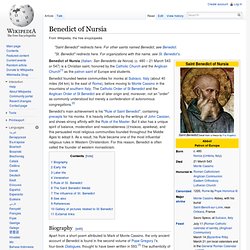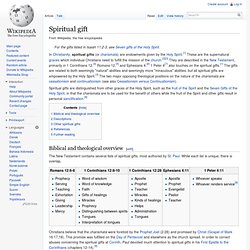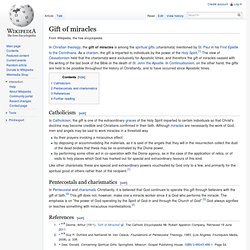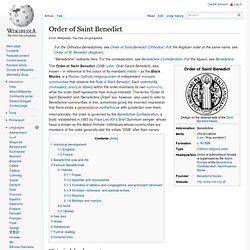

Lazarus of Bethany - Wikipedia, the free encyclopedia - Iceweasel. The Raising of Lazarus, by Duccio, 1310–11 The Raising of Lazarus or the Resurrection of Lazarus is a miracle of Jesus, in which Jesus brings Lazarus back to life four days after his burial.[1][2] The story is told only in the Gospel of John (John 11:1-46).

Jesus is informed by messengers that Lazarus is ill, and that his two sisters are seeking his help. Jesus tells his followers that he intends to wait for Lazarus to die, in order that he (Jesus) may be glorified: "This sickness will not end in death. Jesus then delays for two days. "Lazarus is dead, and for your sake I am glad I was not there, so that you may believe. " "I am the resurrection and the life. It was around this point that Jesus wept. "Father, I thank you that you have heard me. When he had said this, Jesus called in a loud voice, "Lazarus, come out! " Saint Maurus - Wikipedia, the free encyclopedia - Iceweasel. Saints Maurus and Placidus are venerated together on 5 October.[1] The Legendary Life of St.

Maurus[edit] A long Life of St. Maurus appeared in the late 9th century, supposedly composed by one of St. Maurus's 6th-century contemporaries. Benedict of Nursia - Wikipedia, the free encyclopedia - Iceweasel. Benedict of Nursia (Italian: San Benedetto da Norcia) (c. 480 – 21 March 543 or 547) is a Christian saint, honored by the Catholic Church and the Anglican Church[1] as the patron saint of Europe and students.

Benedict's main achievement is his "Rule of Saint Benedict", containing precepts for his monks. It is heavily influenced by the writings of John Cassian, and shows strong affinity with the Rule of the Master. But it also has a unique spirit of balance, moderation and reasonableness (ἐπιείκεια, epieikeia), and this persuaded most religious communities founded throughout the Middle Ages to adopt it. As a result, his Rule became one of the most influential religious rules in Western Christendom. For this reason, Benedict is often called the founder of western monasticism. Biography[edit] Gregory’s account of this saint’s life is not, however, a biography in the modern sense of the word. Gregory did not set out to write a chronological, historically anchored story of St. Early life[edit] Spiritual gift - Wikipedia, the free encyclopedia - Iceweasel.
Spiritual gifts are distinguished from other graces of the Holy Spirit, such as the fruit of the Spirit and the Seven Gifts of the Holy Spirit, in that the charismata are to be used for the benefit of others while the fruit of the Spirit and other gifts result in personal sanctification.[8] Biblical and theological overview[edit] The New Testament contains several lists of spiritual gifts, most authored by St.

Paul. While each list is unique, there is overlap. Christians believe that the charismata were foretold by the Prophet Joel (2:28) and promised by Christ (Gospel of Mark 16:17,18). In 1 Corinthians 12, two Greek terms are translated as "spiritual gifts". From these scriptural passages, Christians understand the spiritual gifts to be enablements or capacities that are divinely bestowed upon individuals. Descriptions[edit] Evangelist: An evangelist is one who devotes himself to preaching the gospel.
Pastor: This term derives from a Greek word for "shepherd". Visions. References[edit] Gift of miracles - Wikipedia, the free encyclopedia - Iceweasel. Catholicism[edit] In Catholicism, the gift is one of the extraordinary graces of the Holy Spirit imparted to certain individuals so that Christ's doctrine may become credible and Christians confirmed in their faith.

Although miracles are necessarily the work of God, men and angels may be said to work miracles in a threefold way. Order of Saint Benedict - Wikipedia, the free encyclopedia - Iceweasel. The Order of Saint Benedict (OSB; Latin: Ordo Sancti Benedicti), also known – in reference to the colour of its members' habits – as the Black Monks, is a Roman Catholic religious order of independent monastic communities that observe the Rule of Saint Benedict.

Each community (monastery, priory or abbey) within the order maintains its own autonomy, while the order itself represents their mutual interests. The terms "Order of Saint Benedict" and "Benedictine Order" are, however, also used to refer to Benedictine communities in toto, sometimes giving the incorrect impression that there exists a generalate or motherhouse with jurisdiction over them.
Internationally, the order is governed by the Benedictine Confederation, a body, established in 1883 by Pope Leo XIII's Brief Summum semper, whose head is known as the Abbot Primate. Individuals whose communities are members of the order generally add the initials "OSB" after their names.